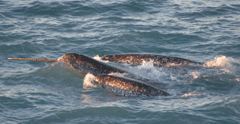Emerging Science Note/Narwhals Track Climate Change
Air Date: Week of May 4, 2007

Narwhals swimming in Baffin Bay (off the coast of Greenland). (Photo: Kristin Laidre/Polar Science Center/APL/University of Washington)
Researchers are looking to small whales called narwhals for information about climate change. Meghan Vigeant reports.
Transcript
[NARWHALS]
VIGEANT: A Cracker Jack team of researchers has been at work this winter bravely diving and swimming in the chilly arctic waters between northern Canada and Greenland.
[THEME]
VIGEANT: The divers have been gathering data beneath the ice of Baffin Bay. You can spot them when they surface by their unusual tusks. Oh, that’s right, these novice oceanographers are actually narwhals, sometimes known as the “unicorn of the sea.”
The single, long, spiraled tooth growing from a male narwhal’s upper lip was likely the origin of the myth of the unicorn. Fairy-tales aside, now these narwhals are getting the facts.

Narwhals swimming in Baffin Bay (off the coast of Greenland). (Photo: Kristin Laidre/Polar Science Center/APL/University of Washington)
The data Leidre and the narwhals are collecting may help climatologists answer big questions about what’s going on as the region warms and more ice melts. The narwhals winter home of Baffin Bay is tied to the Gulf Stream, a major influence on the climate of North America and Europe. But the bay’s dense winter ice cover has made it difficult for scientists to get temperature data. Now, with the help of nature’s legendary unicorn of the sea, the picture may become clearer.
And that’s no fairy tale.
Living on Earth wants to hear from you!
Living on Earth
62 Calef Highway, Suite 212
Lee, NH 03861
Telephone: 617-287-4121
E-mail: comments@loe.org
Newsletter [Click here]
Donate to Living on Earth!
Living on Earth is an independent media program and relies entirely on contributions from listeners and institutions supporting public service. Please donate now to preserve an independent environmental voice.
NewsletterLiving on Earth offers a weekly delivery of the show's rundown to your mailbox. Sign up for our newsletter today!
 Sailors For The Sea: Be the change you want to sea.
Sailors For The Sea: Be the change you want to sea.
 The Grantham Foundation for the Protection of the Environment: Committed to protecting and improving the health of the global environment.
The Grantham Foundation for the Protection of the Environment: Committed to protecting and improving the health of the global environment.
 Contribute to Living on Earth and receive, as our gift to you, an archival print of one of Mark Seth Lender's extraordinary wildlife photographs. Follow the link to see Mark's current collection of photographs.
Contribute to Living on Earth and receive, as our gift to you, an archival print of one of Mark Seth Lender's extraordinary wildlife photographs. Follow the link to see Mark's current collection of photographs.
 Buy a signed copy of Mark Seth Lender's book Smeagull the Seagull & support Living on Earth
Buy a signed copy of Mark Seth Lender's book Smeagull the Seagull & support Living on Earth

